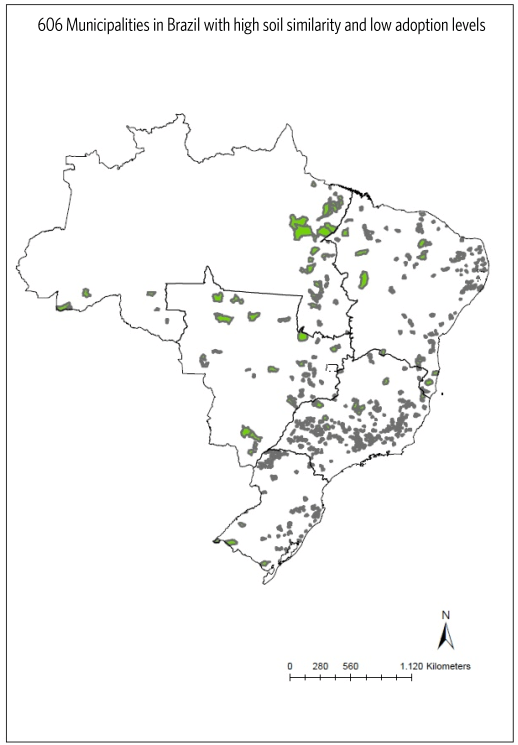In business, it is unusual to find a technology that proves to be better and costs less than the one in use. In theory, that technology should spread like wildfire and quickly replace current production methods. If it doesn’t, there is usually a barrier that prevents its spread.
In a new CPI study, we examine a farming technology called the Direct Planting System (DPS) which has proven to be one of the most important developments in agriculture in the past decades – however, after nearly forty years of its introduction in Southern Brazil, only 10% of Brazilian farmers reported using it in the 2006 Agricultural Census. The questions we address in this study are: What is keeping this technology from spreading and how do we overcome this barrier?
Our analysis reveals that soil composition is an important factor affecting the spread of the DPS. When soils are similar in a given municipality, it is easier for farmers to learn from the experience of peers who have already successfully adopted the system. Likewise, differences in the soil can act as a barrier to the expansion of DPS, since the system would have to be adapted to different soils.
The DPS was initially developed in the beginning of the 1970s and evolved into a system with higher returns and lower costs than traditional farming. Adoption of the DPS does not have any relevant upfront costs and results in more reliable yields than traditional farming. Moreover, carbon emissions from agricultural activity are lower. However, the spread of the system relied essentially on private efforts as the public sector did not get involved in training until very recently. During this earlier period, farmers had to learn the system from peers who had already adopted it. Yet adoption rates remain low.
Soil composition is an important factor for the diffusion of the DPS
Additionally, we estimate that alternative diffusion channels also increase DPS adoption. Private training centers increase adoption by 8.6%. Farmers’ cooperatives, where farmers can share knowledge, increase adoption by 18.6%. These alternative diffusion channels strengthen the learning-from-peers channel instead of replacing it. If used, these channels can help raise the adoption levels just to the point where learning from peers becomes effective. The Clube da Minhoca (literally translated as “Earthworm Club”), a private center run by the Brazilian Federation of Direct Planting that provided temporary training in municipalities across the country, is an example of an alternative channel that could work temporarily in municipalities with low adoption rates, to raise these levels to where learning takes place easily. Financial credit programs are not enough to drive adoption Our results also show that a financial program such as subsidized credit from the Agricultura de Baixo Carbono program (ABC – Low-Carbon Agriculture, implemented in 2010), designed to encourage farmers to adopt the DPS, is not enough to drive the system expansion. This is because there are other, non-financial barriers to adoption. This is particularly relevant as the main policy tool for Brazilian agriculture today is the Plano Agrícola e Pecuário (Agricultural Plan), which offers subsidized credit and has a budget around R$130 billion. Policy implications Our results have two key policy implications. First, public investment in training can reinforce learning from peers, which is an important channel in the spread of new methods and technologies in agriculture. It follows that the easier it is to learn, the faster a new system will spread. Many policy tools can help facilitate learning from peers: improved education; alternative dissemination channels; collaboration between farmers and research centers; and using farmers’ associations to spread knowledge. Second, our results suggest that the initial phase of adoption is the most important – especially if soil composition is similar. Afterwards, learning from peers will develop naturally. It follows that the government needs only establish temporary training facilities, which may move on to different regions after adoption levels reach a certain threshold (which will depend on environmental conditions). If resources are limited, policy makers should focus on regions with similar soils and low adoption levels to raise them to intermediate levels where social learning takes place more easily. The data used for this study identifies 606 municipalities with relevant agricultural activity where these two conditions are met, and therefore should be targeted by policymakers. This post was also published on Climate-Eval. Through empirical analysis, we found that similar soil encourages the spread of the DPS through learning-from-peers. However, Brazil’s regions and municipalities have dissimilar soils; we estimate that adoption of DPS would be 7.1% higher if Brazil were covered by only one type of soil. We also estimate that learning-from-peers is most effective in municipalities where adoption is already at an intermediate stage, between 18% and 50%, when there are enough farmers who have had experience with DPS. At higher levels of adoption, other channels of diffusion are available, so learning from peers is less important.
Through empirical analysis, we found that similar soil encourages the spread of the DPS through learning-from-peers. However, Brazil’s regions and municipalities have dissimilar soils; we estimate that adoption of DPS would be 7.1% higher if Brazil were covered by only one type of soil. We also estimate that learning-from-peers is most effective in municipalities where adoption is already at an intermediate stage, between 18% and 50%, when there are enough farmers who have had experience with DPS. At higher levels of adoption, other channels of diffusion are available, so learning from peers is less important.

